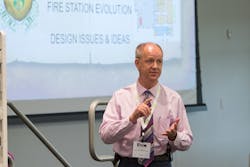Station Design: Let's Get a Lasso Around Your Project
Whether it’s your first fire station project, or your 10th, ideas need to be put on paper. Checklists are a plenty. Changes need to be tracked. Permits need to be pulled. Budgets need to be reviewed. Purchasing decisions agreed upon. The list is endless.
And it’s not just the list that is endless. The myriad people you will communicate with goes on and on. Architects, contractors, construction bosses, electricians, furniture and appliance dealers, community members, etc.
Following opening remarks, architect Ken Newell, of Stewart Cooper Newell Architects, opened the 2018 Station Design Conference with a session titled “Let's Get a Lasso Around Your Project.” His program followed the Western-town motto of Fort Worth, TX, and his entertaining PowerPoint slides had a Western theme.
Newell, who has worked on over 400 fire station projects in 26 states, took Station Design attendees on a walk through the fire station construction journey from start to finish, offering tons of advice.
Selecting your site
When selecting the location for the construction project, Newell said there are number of visible and non-visible challenges that can increase costs and add delays to completing the station.
Visible site challenges include:
- Boundaries
- Topography
- Utilities
- Tree lines
- Existing structures
Non-visible items includes:
- Hard soils/rocks
- Water tables and marsh lands
- Utilities
- Hazardous materials used in construction
- Hazard materials that infiltrated the ground
- Historic burial sites
“Often times people move forward into projects without considering these things and that’s when they get in trouble” Newell said. “It’s a bad day when you get out to a construction sites and you see thing things.”
Newell said the best way to work around many of these issues is to building on previously undeveloped land.
Project delivery methods
There are several common practices that are used from the idea phase until construction is complete, including four common types used for public safety facilities:
- Design-Bid-Build—the most prominent type where fire departments hire an architect who works for them and helps through the entire process. The fire department then works with separate contractors to build out the project.
- Construction Management at Risk—this process is gaining popularity for public safety projects. This is when a contractor is brought in during the design process to develop early budget costs. The early estimates allow fire departments to get a better idea of design concepts that are affordable and functional without running into financial issues during the construction stage.
- Design Build—when a fire department hires a contractor first, and the contractor brings their preferred architect into the project.
- Construction Management—this was a popular choice in the 1980s, when a third-party firm is hired and they hire the architect and contractors to complete the project on behalf of the fire department.
Funding and costs
Existing structures, such as the current fire station, or other structures on a newly acquired site can create a funding stream, and Newell said that’s often overlooked during fire station projects. If a builder seeks a current fire station site for a project and the station can be relocated nearby—not affecting the response times or ISO ratings—Newell said that sale can provide significant funding for a new, modern station.
Project managers and fire departments need to have realistic goals and a solid understanding of what the budget is when they go into the design process.
“If you tell us that you need a $4 million station and you can only afford a $3M station, you’ve wasted a lot of time,” Newell said.
One of the common misconceptions when it comes to budgeting is what the contractor provides in the estimate, which is called the hard costs for site work, building materials, landscaping, and labor. Newell said the soft costs, which include fixtures, furniture, legal and finance fees are often overlooked. He said the hard costs are usually 75 percent of the total project and the soft costs are 25 percent of the overall cost.
When talking with fire service personnel, he said they are often caught off guard by the number of times large payments are due. He offered the following four timeframes for the biggest payouts:
- Acquisition of property—when new property needs to be purchased, including land surveys and the legal paperwork.
- Planning and design—when architects, planners and contractors are brought in and some retainers or deposits are collected.
- Construction period—usually a long-term process that could include several payments over six months, a year or longer, based on the project timeline.
- Occupancy phase—when furniture, fixtures, appliances and other necessities are purchased and then installed.
Newell cautioned that many departments don’t factor in the costs of moving crews and their equipment from the old station to the new station during the occupancy phase. It could require additional crews to cover when firefighters are moving and setting up their new home.
In the 10-year period leading up to 2017, construction costs rose by 22 percent, so departments considering projects in the future, or postponing current plans need to consider those additional dollars.
“Every month that goes by, you’ll have to come up with two percent more of your money,” Newell said.
When it comes to long-term maintenance at the station, Newell said that it will ultimately cost more than the initial design and building.
Design phase
Breaking fire stations into zones, including public, private and bays/support, will help architects begin their work with a solid foundation, bringing an understanding to how the station should flow.
Firefighters need to discuss what areas the public will be allowed into, such as the lobby, offices or community spaces. Private areas could include living spaces, bunk rooms and fitness space.
Once those spaces are determined, public parking should not be placed adjacent to private areas to avoid them from stumbling into the wrong sections of the station.
Trends
The ongoing findings from firefighter cancer research is having a huge impact on the design of fire stations.
From hot zones where contaminants need to be isolated, to air-handling systems and firefighter decontamination, Newell said stations will see changes. He expects OSHA to convert some of the current trends into laws within 10 years to reduce firefighters’ exposure, but recommended departments begin implementing them because of the longevity of the stations and the additional costs to retrofit them in the future.
The use of private bathrooms and bedrooms continue to grow in popularity and it helps as municipalities who are looking to meet gender-neutral requirements.
“The one thing you need to do to in the design phase is determine the male to female firefighter ratio in the station,” Newell said. “If you dedicate a female-only restroom and there’s only one on the shift or in the station, you have rooms you can’t use for majority of shifts.”
Departments are also looking to increase the ability to train at and inside stations, so departments are incorporating training towers, stairwells, and various training props into the structures. Newell suggested departments discuss their training needs beforehand to help develop the appropriate spaces that will allow firefighters to build their skills.
Touring training centers and taking photos of props or ideas that you would like to include in your station is helpful.
Newell said departments are adding mezzanines in open areas for ladder or rope rescue training, training towers for aerial and hoseline training and props for utility management training, such as sprinkler heads and electrical panels.
As departments add new facilities, many of them include the co-location of other agencies, whether it’s a police station, community center or local government facility.
“One of the trends that we’ve seen that does eventually impact the stations is that volunteer fire departments need to prepare for the transition to career,” Newell said.
He said parking stations near the bays allow volunteers to quickly access their gear and the apparatus, but when personal vehicle security for career firefighters is needed, it should be located elsewhere.
Large bunk rooms that can be used by volunteer stations for the occasional storm standby do not function for part-time or full-time staffing, so careful consideration needs to be used moving to around-the-clock staffing where members will have to store bedding and personal items.
When it comes to furnishings, more departments are looking to maintenance-free ideas, Newell said, noting that firefighters don’t always have the time to perform major upkeep.
Experience pays off
During the presentation, Newell stressed the importance of working with architects or planners who have experience in public safety facilities because of NFPA standards, ISO and OSHA requirements.
Fire stations are not traditional commercial buildings since they are used 24 hours a day, 365 days a year.
Architects with previous fire station experience bring an understanding of the workflow and design must-haves that departments need.
“You’ve got a building full of professionals here. You want to bring someone on board who can build a firehouse,” Newell said. “I’m sure they can build a house or a funeral home, but not a fire station.”
“You need to develop stations that last 75 years,” Newell said as his presentation ended.
About the Author
Peter Matthews
Editor-in-Chief/Conference Director
Peter Matthews is the conference director and editor-in-chief of Firehouse. He has worked at Firehouse since 1999, serving in various roles on both Firehouse Magazine and Firehouse.com staffs. He completed an internship with the Rochester, NY, Fire Department and served with fire departments in Rush, NY, and Laurel, MD, and was a lieutenant with the Glenwood Fire Company in Glenwood Landing, NY. Matthews served as photographer for the St. Paul, MN, Fire Department and currently is a photographer for the Fort Worth, TX, Fire Department.

